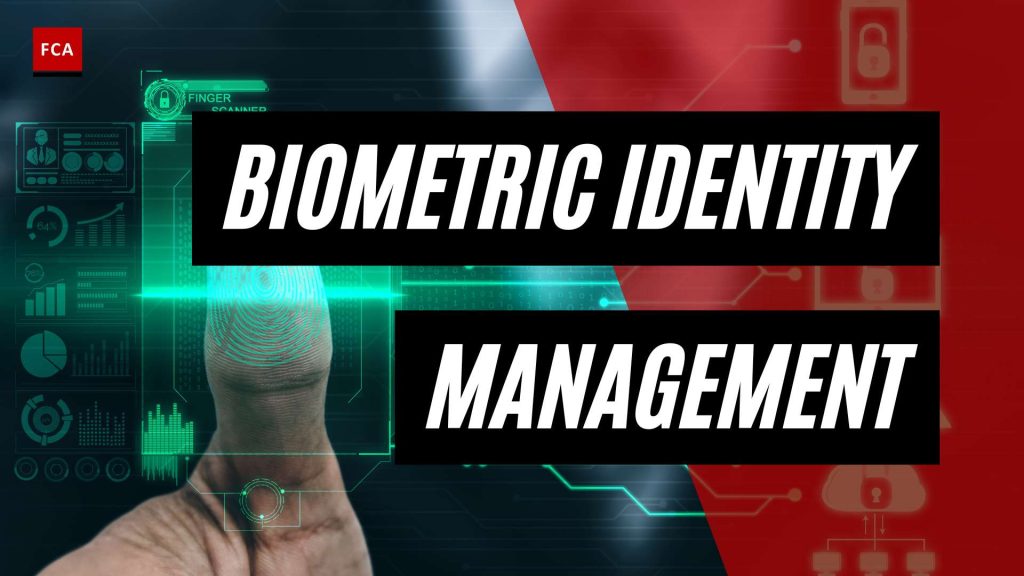Understanding Biometric Identity Management
As the world continues to grapple with the ever-increasing threat of financial crimes, organizations are turning towards advanced technology solutions like biometric identity management to strengthen their anti-money laundering (AML) efforts.
What is Biometric Identity Management?
Biometric identity management refers to a range of techniques, devices, and systems that leverage unique physiological or behavioral characteristics of individuals to recognize or authenticate their identities. These characteristics, including but not limited to facial features, fingerprints, voice patterns, iris or retina, or gait, are highly distinctive and can serve as the foundation for robust and reliable identification systems (Office of the Privacy Commissioner of Canada).
Biometric data is collected at the time of enrollment and can be used to establish or authenticate identities when new data is collected and compared with stored records. This makes biometric identity management an effective tool in enhancing security, preventing fraud, and assisting in compliance with AML regulations.
How Does Biometric Verification Work?
Biometric verification involves the comparison of biometric data captured in real-time with the biometric data stored in the system. For instance, in fingerprint-based biometric systems, the system captures a fingerprint image, extracts its unique features, and compares it with the stored fingerprint template. If the system finds a match, the identity of the individual is verified.
Certain physical characteristics, such as fingerprints and irises, are stable over time and difficult to alter, which makes them reliable for long-term identification. On the other hand, characteristics like faces change over time and can be varied through cosmetics, disguises, or surgery, which may pose challenges for biometric systems relying on these features.
Biometric verification plays a critical role in various sectors, from healthcare and law enforcement to financial services, where it assists in transaction monitoring and watchlist screening. However, the use of biometric data also raises privacy concerns, which need to be carefully addressed in the design, implementation, and operation of biometric systems. It’s essential to balance security needs with privacy rights, ensuring privacy safeguards such as storing biometric information locally instead of in centralized databases and considering less privacy-invasive methods when collecting and using biometric information (Office of the Privacy Commissioner of Canada).
Biometric identity management, with its potential to deliver secure, convenient, and efficient identity verification, is poised to play an increasingly important role in AML efforts. By understanding how this technology works and addressing associated privacy concerns, organizations can harness its full potential to secure the future. For more information on different biometric verification technologies, visit here.
Biometric Verification Techniques
Biometric verification techniques form the backbone of biometric identity management. These techniques involve the analysis of unique biological and physiological characteristics to confirm a person’s identity. This section reviews three key types of biometric verification techniques: physiological, behavioral, and multi-modal biometrics.
Physiological Biometrics
Physiological biometrics involve the analysis of physical characteristics unique to an individual. The five common types of biometric identifiers include fingerprints, facial features, voice, iris patterns, and palm/finger vein patterns.
For instance, fingerprint recognition is a well-known physiological biometric method that uses different technologies, such as optical sensors, linear thermal sensors, and capacitive authentication sensors, to authenticate data. Another example is iris recognition, which is considered one of the most accurate biometric authentication methods. It involves various steps like locating the pupil, detecting the iris, and excluding unnecessary parts to verify an identity through numerical values representing the iris image.
These physiological biometric techniques are increasingly being integrated into everyday devices like smartphones, laptops, and tablets, offering users a convenient and secure way to access their devices and online accounts.
Behavioral Biometrics
Behavioral biometrics involve the analysis of the unique ways in which individuals behave, including voice, typing rhythm, gait, and other behavioral traits. Voice recognition, which is a combination of physical and behavioral biometrics, offers convenience by simultaneously analyzing the dynamic and static characteristics of the human voice (Phonexia).
These behavioral characteristics are difficult to mimic or steal, making them a highly secure form of biometric verification. As behavioral biometrics are based on actions rather than physical characteristics, they can continuously authenticate users’ identities without causing any interruption or inconvenience.
Multi-modal Biometrics
Multi-modal biometrics combine two or more biometric verification methods, providing a higher level of security. By utilizing multiple biometric traits, multi-modal systems can significantly reduce the rate of false positives and false negatives, improving the overall accuracy of the biometric authentication system.
Multi-modal biometrics can integrate a combination of physiological and behavioral biometrics. For instance, a system might combine fingerprint recognition with voice recognition to ensure a higher level of security. These systems are particularly useful in high-security applications where accuracy is paramount.
As biometric verification continues to evolve, it’s crucial for organizations to stay abreast of the latest advancements in biometric verification technologies to enhance their biometric compliance solutions and prevent fraud.
Biometric Verification in Various Sectors
The implementation of biometric identity management has been transformative across numerous industries, enhancing security and improving user experiences. Let’s explore how biometric verification is being applied in healthcare, law enforcement, and financial sectors.
Biometrics in Healthcare
In healthcare, biometric verification is increasingly being utilized for patient identification. This application ensures that the correct patient receives the appropriate treatment and medication, effectively enhancing patient safety and reducing medical errors. By matching patients to their unique biometric data, healthcare providers can ensure the integrity of their services and significantly improve overall patient outcomes. Explore more about biometric authentication systems for seamless and secure patient identification.
Biometrics in Law Enforcement
Biometric technology is revolutionizing law enforcement by improving the effectiveness of criminal investigations. Law enforcement agencies can match suspects against watchlists and identify individuals in surveillance footage using biometric data, leading to expedited crime resolution and enhanced crime prevention. Discover the potential of biometric fraud prevention methods in law enforcement.
Biometrics in Financial Services
In the financial services sector, biometric identity management is becoming an integral part of customer authentication processes. Secure and seamless authentication reduces the potential for fraud, and by providing a seamless user experience, enhances customer trust and loyalty. Biometric authentication methods enable tasks such as unlocking mobile devices with fingerprints and conducting financial transactions through voice commands (Phonexia).
The adoption of biometric technology in financial services has led to the development of biometric KYC solutions, biometric transaction monitoring, and biometric watchlist screening, all contributing to robust anti-money laundering measures.
Across these sectors, biometric verification technologies offer accuracy and reliability in identification processes, thus enhancing security, efficiency, and user experiences (Iberdrola). As technology continues to evolve, we can anticipate even more innovative applications of biometric verification, particularly with the advent of multi-modal biometric systems.
Privacy Concerns with Biometric Verification
While the use of biometric identity management systems offers significant benefits in various sectors, it also raises certain privacy concerns. Biometric data, inherently personal and unique, can potentially be misused if not handled with adequate safeguards. This section will discuss some of these concerns and how they can be addressed.
Covert Collection and Use of Biometric Data
One of the main privacy concerns with biometric systems is the covert collection and use of biometric data. Biometric information such as facial features, fingerprints, iris patterns, palm and finger vein patterns, and DNA could be used to track or monitor individuals’ movements without their knowledge or consent. This collection raises privacy concerns, especially when information is used for purposes beyond its original intent, leading to fears of function creep and potential misuse of personal data.
The covert collection and use of biometric data can undermine trust in biometric identity verification systems and potentially lead to violations of privacy laws. Therefore, it’s crucial for organizations implementing biometric verification technologies to ensure transparency in their data collection and use practices.
Cross-matching and Secondary Information
Another concern with biometric verification systems is the possibility of cross-matching biometric traits collected for one purpose with different purposes without consent. This could potentially reveal additional personal information beyond the primary purpose of collection.
For instance, biometric data collected for security purposes could potentially be cross-matched with data from other sources to glean additional information about an individual’s health status, lifestyle, or other personal details. This practice could potentially infringe on an individual’s privacy rights and lead to unauthorized use of personal information.
Implementing Privacy Safeguards
Given these concerns, it’s essential for organizations to implement robust privacy safeguards when using biometric verification systems. These safeguards can include recording summary information instead of raw data, using biometric information for verification rather than identification, and storing biometric information locally instead of in centralized databases.
Furthermore, organizations should consider less privacy-invasive methods or alternatives when collecting and using biometric information. They should also ensure that they comply with relevant privacy laws and regulations, such as the Privacy Act in the federal government and the Personal Information Protection and Electronic Documents Act (PIPEDA) in private-sector organizations.
As the use of biometric authentication systems continues to grow, it’s critical for organizations to balance the benefits of enhanced security and convenience with the need to protect individuals’ privacy rights. By implementing robust privacy safeguards and ensuring transparency in their data collection and use practices, organizations can leverage the benefits of biometric verification while minimizing potential privacy risks.
Advancements in Biometric Technology
Biometric technology is rapidly evolving, with advancements like touchless fingerprint recognition, facial recognition, and voice biometrics, offering enhanced security and convenience to users across various industries. These technologies are increasingly being adopted as part of biometric identity management systems, providing a secure, fast, and efficient way to authenticate individuals through unique biological characteristics (Iberdrola).
Touchless Fingerprint Recognition
Touchless fingerprint recognition is an innovative biometric technology that allows for the capture and analysis of fingerprint data without the need for direct contact. This advancement not only enhances the user experience by offering a non-intrusive method of identification but also increases the accuracy and reliability of the fingerprint data.
In addition, touchless fingerprint recognition addresses hygiene concerns associated with contact-based fingerprint scanners, making it a more appealing option in settings where cleanliness is paramount. This technology is increasingly being adopted in sectors such as banking, healthcare, border control, and law enforcement as part of their biometric verification technologies.
Facial Recognition
Facial recognition technology has seen significant advancements in recent years, with improved accuracy and the ability to handle variations in lighting, pose, and expression. This technology analyzes unique facial features to accurately identify and authenticate individuals.
Applications of facial recognition technology extend beyond just unlocking smartphones. It is now being utilized in various sectors such as law enforcement for surveillance purposes, in airports for passenger screening, and in financial services for biometric transaction monitoring.
Voice Biometrics
Voice biometrics is another emerging technology in the field of biometric identity management. This technology analyzes unique voice patterns to verify an individual’s identity. Unlike passwords or PINs, voice biometrics can’t be forgotten or lost, offering a seamless and secure user experience.
Voice biometrics is particularly beneficial in sectors where remote authentication is required, such as call centers or telebanking. It offers an additional layer of security, helping in biometric fraud prevention by ensuring that the person on the other end of the line is indeed who they claim to be.
These advancements in biometric technology are transforming the way identity management is conducted, offering enhanced security and convenience. As these technologies continue to evolve, they will play an increasingly pivotal role in shaping the future of biometric compliance solutions and biometric KYC solutions.
Balancing Security and User Experience
The implementation of biometric identity management involves a delicate balance between security and user experience. The effectiveness of these systems relies on setting appropriate thresholds, understanding the risk of false rejections, and continually improving the user experience.
Setting Thresholds in Biometric Systems
The security and accuracy of a biometric authentication solution are significantly influenced by the thresholds set by administrators. Stricter thresholds enhance security but may lead to a higher false rejection rate, while more lenient thresholds might decrease security but improve user experience.
Therefore, professionals working with biometric compliance solutions should be knowledgeable about the nuances of setting these thresholds. They must strike a balance that prevents unauthorized access and fraud while ensuring that genuine users are not inconvenienced by high false rejection rates.
The Risk of False Rejection
While biometric verification technologies offer superior security, there’s a risk of false rejections. This occurs when a genuine user is incorrectly denied access due to a mismatch between their current biometric sample and the one stored during enrolment.
False rejections can be frustrating for users and may lead to a poor user experience. Therefore, it’s crucial to ensure that biometric systems are precisely calibrated and tested regularly to minimize this risk. Furthermore, the use of multi-modal biometric systems can help reduce false rejection rates by providing multiple ways of verifying a user’s identity.
Improving User Experience
Biometric authentication is not only secure but also convenient and fast for users. Placing a finger on a scanner and unlocking an account is faster than typing out a long password. Users are also less likely to forget their own biometrics compared to passwords.
Biometric data is also non-transferable, requiring the physical presence of the user’s biometric input for authorization. This enhances the inherent security of these systems while also making the user experience smooth and intuitive.
In conclusion, balancing security and user experience is a critical aspect of implementing biometric authentication systems. By setting appropriate thresholds, minimizing false rejections, and focusing on user experience, organizations can leverage the full potential of biometric technologies for anti-money laundering and other compliance activities.








